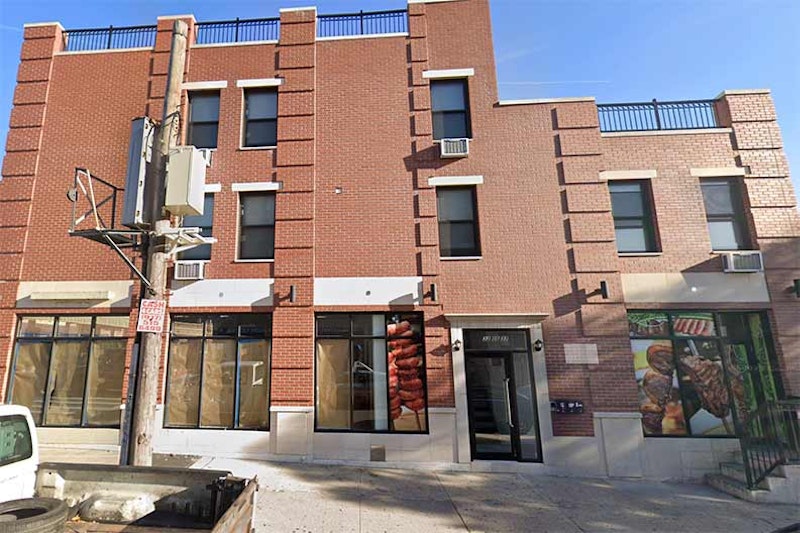In Queens, there are worlds within worlds. Needing exercise, I took a different route to the subway in Astoria one day and turned right on Broadway onto 37th St. I knew about 37th St. from its role in world industrial history (see below for that) but wasn’t prepared for the variety of architecture in the single block between Broadway and 34th Ave.. Much of Astoria features blocks of apartment buildings, handsomely constructed, but seemingly turned out by photocopier. Some blocks, though, betray their age, with buildings of a century or better pressed up against the newest architectural stylings that will look dated and of their time in what’s likely 20 years.
Speaking of photocopiers, the above building at Broadway and 37th St. is where the machine was invented. The side entrance is marked “32-05 37th Street” and it leads upstairs to the place where xerography, a.k.a. photoelectric copying, known today universally as the Xerox machine, was invented. “Xerox” has come to mean all copiers, as “Coke” in some parts means all flavored carbonated beverages, even though both are registered trademarked brands.
The short story: Chester Carlson (1906-1968) was born in Seattle and his Swedish immigrant family kicked around the West for a few years, even residing in Mexico, before settling in San Bernadino, CA; Chester Carlson attended the California Institute of Technology and received a B.A. in physics in 1930. He accepted a job as a research engineer at Bell Labs in Manhattan, a building on West and Bethune Sts. in Greenwich Village that is today an artists’ colony known as Westbeth. Carlson requested and got a transfer to the company’s patent office because he was interested in the new technology coming into its own, despite the Depression, such as television.
Carlson was interested in the graphic arts from childhood and had always lamented that other than carbon paper, stencil duplicators (or mimeographs) or re-typing, there was no good way to quickly produce multiple legible copies of documents. He realized that the production of such copies would have to involve the photographic process. Renting an apartment in Jackson Heights, he began to experiment with silver halide, which enables light to initiate chemical changes, and experimented with photoconductivity, the interaction of electricity with light. In October 1938 he enlisted the help of German-born Otto Kornei who’d fled his homeland during the Nazi regime. The partners rented a back room at 32-05 37th St. and made a breakthrough on October 22nd, 1938, when the first photocopy of a sheet of paper, inscribed “10-22-38 Astoria,” was made.
Carlson obtained a patent in 1940, one of 28 during his life, shopped around models of the photocopier to various companies including IBM, but the USA was at war and new commercial inventions weren’t given priority by most of the places he contacted. Finally he signed with Battelle Development Corporation, a subsidiary formed by Battelle Memorial Institute for the specific purpose of sponsoring new inventions, in October 1944, and received the support of a major corporation to refine his invention to make it commercially viable. The Haloid Company partnered with Battelle and Carlson, and the first sale of the Xerox copier, as Haloid called it, was made in 1950. The first commercially successful Xerox machine, the Xerox 914, appeared in 1959; Haloid became the Xerox Corporation.
By the 1960s, Carlson was worth over $50 million, and became a dedicated philanthropist, donating to the NAACP and various organizations championing Zen Buddhism. He perished from a heart attack in 1968.
“To know Chester Carlson was to like him, to love him, and to respect him. He was generally known as the inventor of xerography, and although it was an extraordinary achievement in the technological and scientific field, I respected him more as a man of exceptional moral stature and as a humanist,” said United Nations Secretary-General U Thant at Carlson’s Xerox Corp. memorial in Rochester, NY.

This small, Federal-style wood frame building at 32-23 37th St. is a few doors down from the Carlson Xerox building. It’s meticulously maintained by its owners and may go back to the early-1800s when Astoria’s streets were laid out and buildings were constructed. The owners have a sense of history, displaying a 13-star “Betsy Ross” American flag.

Most Precious Blood, a Roman Catholic parish, is in a modern Romanesque building dating to the 1960s. The church offers Masses in Spanish, Croatian and Tagalog, the principal language of the Philippines, in addition to English, a reflection of its varied congregation.

If you see a two-story or lower residential building that’s squat and close to the ground, it’s been there for a long time. The original configurations of both these buildings have long been obscured under aluminum siding.

A sample of the new trend in residential housing: a flat-topped building with next to no ornamentation and large windows. I don’t know the plans for the front of the building, but they probably don’t include a grassy lawn. Compare the building it its right, likely another original on the block, obscured under heavy reimagining.

Two more 37th St. stylings, a steeply pitched roof on a modest frame building adjacent to a multifamily building likely built in the 1910s or 1920s. Would you like to sit in the attic space under the roof and watch the passing parade? I would.

Some streets in Astoria feature what look to me parts of attached brownstone blocks that’ve been sliced off and transported elsewhere. This one apparently features its original door. There’s a full-length bay which allows an occupant to look up and down 37th St., or did at one time.
—Kevin Walsh is the webmaster of Forgotten NY and the author of Forgotten New York and, with the Greater Astoria Historical Society, Forgotten Queens.

